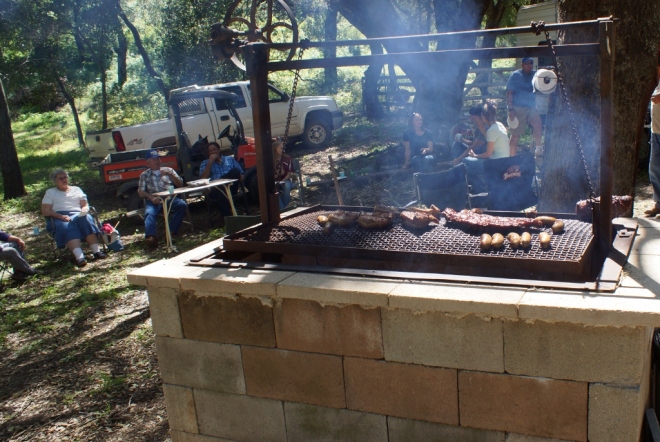
Fern Canyon on the Grieb Ranch is a gathering place for family and friends. Special days such as Easter, Memorial Day, July 4th and Labor Day give us reason to celebrate and create memories.

Easter provided a time to remember Christ’s Resurrection. Memorial Day we took time to remember those who have served our country and then we feasted. At any gathering includes much food and fun – visiting with family and friends and playing badminton and horseshoes.
Memorial Day we enjoyed a roasted sucking pig stuffed with lemon grass. BBQ Tri-Tip and chicken are always a scrumptious staple at these gatherings.
 Roasted Suckling Pigs
Roasted Suckling Pigs
1 suckling pig (approx. 17 lbs)
10 cloves crushed garlic
1 tbsp coarse salt
1 tbsp cracked pepper
Ample vegetables to fill the cavity. Onions, carrots, apples garlic and parsley are recommended (the traditional recipe calls for lemongrass alone).
Heavy wire and a pair of pliers (to stitch the belly of the pig).
3 Cups salt-reduced soy sauce
3 Cups olive oil
a shovel, for moving the hot coals around
Cook’s notes
We cook the pigs over an open barbecue spit. All herbs are fresh (unless specified) and cups are lightly packed. All vegetables are medium size and peeled, unless specified.
Instructions
First, light the barbecue coals. The coals are not ready until white (no flame should be present when cooking). This will take an hour or two.
With a sharp knife, remove the tail and ears of the pig. Turn the pig over and remove the kidneys and any loose fat.
Rub the surface of the pig with crushed garlic, ensuring it is well massaged in. This will add flavor as well as moisten the skin. Once thoroughly massaged, place the remaining pieces of garlic inside the cavity of the pig.
Apply a liberal amount of coarse salt to the skin and massage well. The salt is crucial to dry the skin and create a perfect crackling. Add salt and pepper liberally to the cavity.
Apply a liberal amount of pepper to the skin.
To ensure an even roast, fill the cavity with the roughly chopped onions, carrots, apples, garlic and parsley. Once the cavity is filled, stitch the belly closed with heavy wire, ensuring a tight seal.
Massage the soy sauce into the skin. This will help create a golden-brown color.
To mount the pig on the spit, place it flat on a large bench or table, belly down. Instructions will be provided on how to use the spit attachments (each varies slightly). Ensure you have them all in place as you slide the main axle along the length of the pig. The axle is inserted from the rear of the pig. It is vital that the pig does not slide around on the axle – check it prior to loading onto the spit.
An 8kg pig will require approximately an hour and a half to two hours of roasting time.
With a shovel, move the bulk of the coals to the edges, underneath the legs and shoulders, with only a small amount of coals under the mid-section. The legs and shoulders are the thickest areas and require the most heat.
As the pig cooks, ensure the color remains even. If any patches are lighter in color, move more coals under this area. If an area is darkening too quickly, move coals away.
Occasionally, apply olive oil with a basting brush to improve the crackling.
In the late stages of roasting, the vegetables in the cavity of the pig will soften and release their juices. It’s a good idea to wipe the juices away to maintain an even finish on the skin.
When the knuckles of the pig begin to be exposed, the pig will be close to ready. To test, stop the rotisserie and insert a meat thermometer into the thickest portion of the leg of the pig. A reading over 160 F will indicate the pig is ready. Alternatively, insert a small knife for 30 seconds and remove to test whether the tip of the knife is hot.
It’s important to move the pig to the place you wish to serve it, prior to removing the spit-mounting from it, as the connective tissues will have cooked and the pig may fall apart if it’s moved after the apparatus is removed. Turn the rotisserie off and use tea towels or oven mitts to handle the spit-mounting. You will need two people to move the roasted pig.
Once the pig is in its final position, carefully remove the spit-mounting, carve and serve.




























 Roasted Suckling Pigs
Roasted Suckling Pigs


